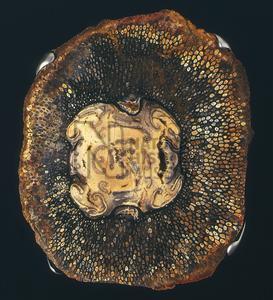 |
 |
 |
 |
 |
Produced
by the Population Genetics and Evolution class, Furman University |
||||
 |
 |
 |
 |
 |
Produced
by the Population Genetics and Evolution class, Furman University |
||||
 |
The
Carboniferous: Psaronius |
 |
||
| Psaronius
is a genus of extinct giant tree ferns. They grew between 10-15 meters
in length and possessed helically arranged leaves between 2-3 meters long
and exhibited large, vertically elongated leaf scars on the apex of their
central strand (Steur 2008, Rothwell 1982). Curiously, these ferns did
not undergo secondary growth formation necessary to produce a woody stem.
Instead, they formed advantageous root mantels for stability which also
caused the base of the trunk to broaden for additional support (Steur
2008). These stems were between 3.6-14.2 centimeters in diameter and were
arranged internally in 3-6 stelar cycles that were separated by aerenchymatous
ground tissue and surrounded by a peripheral sheath for protection and
support (Rothwell 1982). An interesting side note was that additional
epiphytic ferns would grow on these root mantles and not drain resources
from its parental host (Steur 2008). Page by Iggy Gaska |
 |
| Cross section of a tree fern revealing cellular
trunk details. Photo from: The Natural History Museum of London |
|
|
National History Museum.2008. Psaronius brasiliensis Brogniart, fossil true fern. Accessed March 3, 2010. Rothwell GW. Blickle AH.1982.Psaronius Magnificus n. comb., A Marratticlean Fern from the Upper Pennsylvanian of North America. Journal of Paleontology. 56: 459-468. Steur H.2008. Psaronius. Hans’ Paleobotany page. Accessed March 2, 2010. |